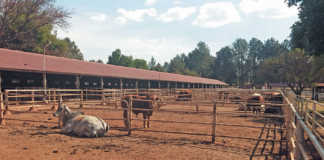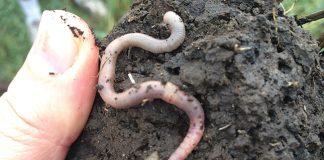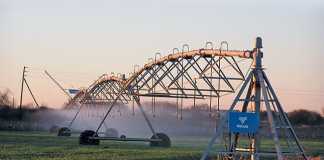The Netherlands has always been at the forefront of developing and introducing new agricultural technology. Having studied the effects of light intensity, wavelength and duration on dairy cows, researchers at the country’s world-renowned Wageningen University found that manipulating these factors influenced milking yield and growth rate.
READ: Higher dairy productivity, lower greenhouse gas levels
Between 16 hours and 18 hours of light per day at a level of 180 lux to 200 lux optimises feed intake and milk yield.
Wageningen University researchers also discovered that:
- Heifers exposed to a 16-hour light and eight-hour darkness cycle reached puberty earlier and at a lower weight than those on identical feed exposed to shorter periods of light. The desired intensity of light on a cow’s eyes is a minimum of 180 lux.
- Longer light hours after calving accelerate the onset of oestrus.
Researchers say these differences are caused by changes in the cow’s blood serum and levels of key hormones that affect her performance in response to changes in light intensity. Cows exposed to longer daylight hours also had reduced levels of melatonin and increased levels of the insulin-like growth factor, IGF–1. These hormones have been proven to increase milk production by between 6% and 15% at 16 hours of daylight, in the following season.
Wageningen University has issued guidelines recommending that dairy cows be exposed to 14 hours to 16 hours of light at a light intensity of 120 lux to 200 lux, and at least six hours of darkness per day.
Case study: ‘free choice’ milking of cows
A recent media tour to the Netherlands included a visit to Anton Stokman’s farm, Haanmeer 3, in the Koudum area in Friesland. Based on the findings of Wageningen University, Stokman implemented a new lighting cycle in his cow barn to improve the health and productivity of his cows.
The high-pressure sodium vapour globes he uses are highly energy-efficient and emit the correct wavelength of light. In winter, the lactating cows are exposed to a light intensity of 180 lux for 16 hours per day. Stokman farms according to the principle that everything that is good for a dairy cow is good for economical production and thus for the farmer.
Therefore, he optimises the cows’ environment and welfare by providing as much free choice as possible. Cows have cubicles for resting, but can freely move to the feeding area on an open floor.
Robotic Milking
Another advanced feature of Stokman’s farming operation is a robotic milking system. Since installing the system, the average yield per cow has increased 10% and the farm’s annual milk yield has risen to an average of 9 500kg per lactation, with 300 cows in milk.
The system enables cows to be milked whenever they want – day or night, seven days a week – and sometimes up to five times per day, depending on the stage of lactation and level of milk production. As a cow’s udder becomes full, she experiences discomfort and seeks out the robotic milking system to be milked.
All cows wear microchipped neck collars, and as they enter the milking stall they are automatically identified by the computerised system. In this way, Stokman is able to establish the frequency of milking. If a cow requires milking, she is fed a pre-determined amount of food. The system then laser-scans her teats, cleans them and automatically attaches the clusters.
Each quarter of the udder is milked individually, in contrast to conventional milking systems. This reduces over- and under-milking as each quarter is monitored while being milked. Milking rate, milk conductivity and yield are also monitored with every milking. This data is used in an early warning system to identify potential health problems.
More feeding time, more milk
Eliminating the unproductive time spent waiting to be milked and optimising productive milking time gives the cow more time to socialise, eat and rest. A cow has to lie down and rest for between 10 hours and 12 hours per day. If time is restricted, resting can take preference over feeding. High lactation cows in particular must be able to eat whenever they need to, as optimal nutrition results in better cow health, welfare and productivity.
In addition to allowing a cow to determine her own daily schedule and improving her milk yield, this technology has improved cow health and reduced somatic cell counts to an average of 160 000. The robotic milking machines are also steam-cleaned to prevent mastitis.
The labour component required for milking in a conventional parlour is also removed with this system, giving staff more time to monitor the cows and carry out other tasks. As a result, both employees and employers have more leisure time, making it easier to employ and retain suitable staff. Stokman spends only 50% of his time managing his farm and employs only one worker.
Waterbeds
Stokman has installed convex dual chamber waterbeds in the cows’ rest cubicles. These waterbeds have a cushioned area for the knees, as well as a separate pocket for the body and hind legs. Although originally a Dutch design, Stokman imported the beds from the USA.
The convex design of the waterbed allows it to return to its original shape when the cow gets up, allowing moisture to flow away from the bed surface, thereby providing a drier and more hygienic surface. It also prevents urine and milk from collecting on the surface and creating conditions for bacterial growth that can cause environmental mastitis. The quantity of bedding material required is also reduced, as the waterbeds receive only a light coating of sawdust.
Studies have shown that waterbeds reduce injuries and provide better and more consistent comfort than other kinds of bedding material. As cows are able to lie down for the required period every day, they are more productive, while lameness is also reduced.
Stokman further reduces lameness in his cows through a strict routine of weekly foot-bathing. Dung is first rinsed off cows’ hooves in a clean water foot bath to prevent contamination of the formalin foot bath through which they walk immediately afterwards.
Flooring
To measure the release of odour and greenhouse gases from the housing system, Stockman undertook research in conjunction with Wageningen University. The study, ‘Measuring Programme for Integral Sustainable Stables’, showed that a ‘free choice’ cow-shed reduced ammonia emission by 35%, odour by 50% and methane by 50%. The total emission reduction in the four sheds was on average 25% for ammonia and 50% for methane.
Each shed has a gutter that runs along the length of the floor and separates urine and faeces. The urine drains into the gutter away from the faeces. Quickly draining the urine into the manure pit reduces the pH level and the amount of ammonia emitted from the slurry.
Part of the manure is deposited onto a grooved non-slip concrete floor in the passageway, which is frequently scraped or flushed. The rest is dropped onto a slatted floor from where it drains into a pit below. Rubber mats with interlocking flaps are fitted to the slatted floors.
Apart from providing a cushioned walking surface for the cows, the mats reduce air exchange between the barn and the manure pit, further reducing emissions and odours. Airflow is maintained with automatically controlled natural ventilation.
The outdoors
In spring and summer, cows are allowed to venture out to an outdoor grassed area. This helps improve their activity levels and provides an alternative, more natural walking surface. Cows are, however, able to return to the barn at will for milking and feeding, or to escape the heat.
Cows can interact with each other in this additional space and show oestrus behaviour more readily if given access to this environment. Stokman works closely with other members of the Dutch farming community to promote his free choice philosophy.
Email Anton Stokman at [email protected].













